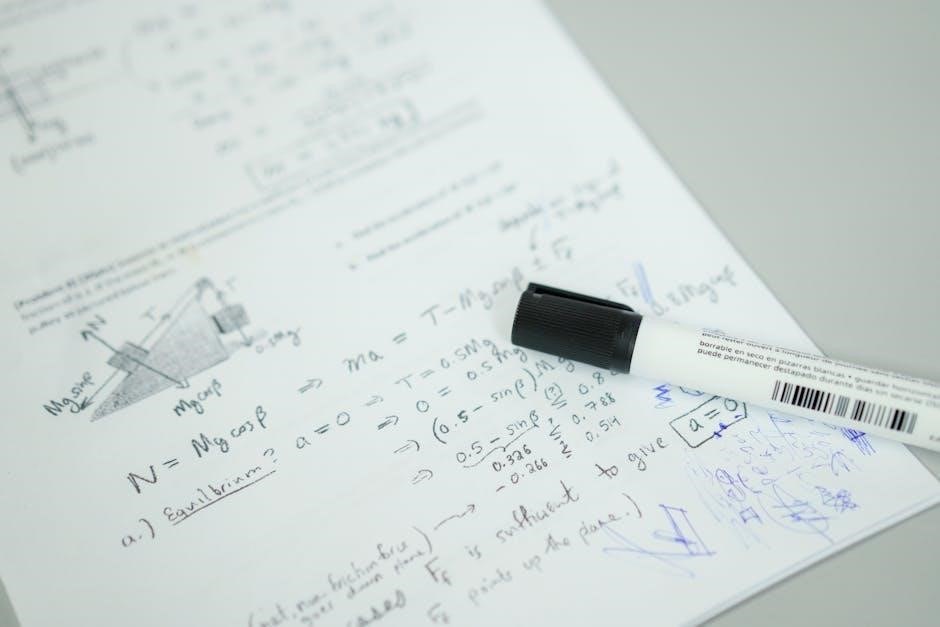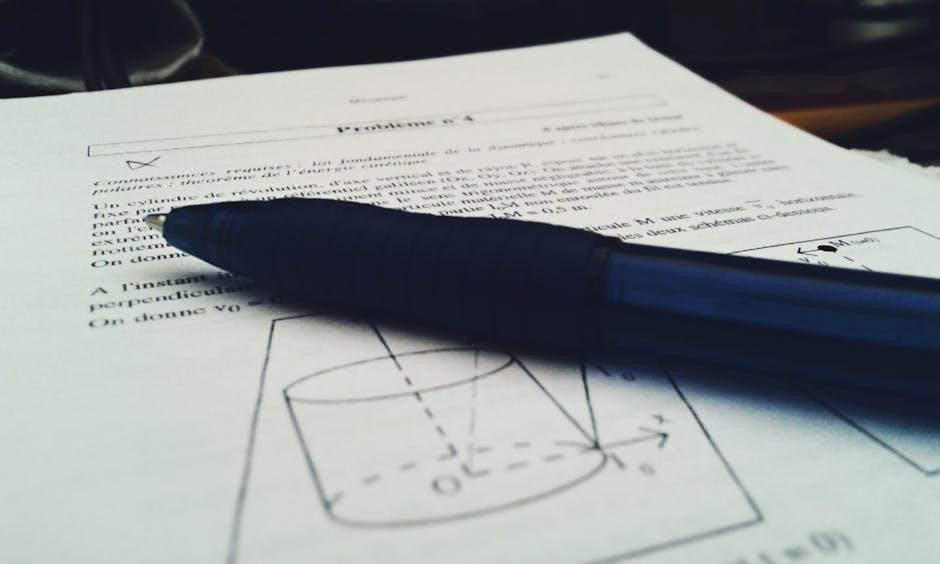AP Physics C: Electricity and Magnetism is a rigorous, calculus-based course designed for advanced students. It covers foundational topics like electric charges, fields, and Gauss’s Law, preparing students for STEM careers with a strong emphasis on analytical and problem-solving skills. This guide provides a comprehensive overview to help students master the material effectively.
1.1. Overview of the Course Structure
AP Physics C: Electricity and Magnetism is structured to cover fundamental topics in depth, including electric charges, fields, Gauss’s Law, and Maxwell’s Equations. The course emphasizes calculus-based problem-solving and integrates theoretical concepts with practical applications. It is divided into units that build sequentially, ensuring a strong foundation in electromagnetism. Students are assessed through exams and free-response questions, requiring both analytical thinking and precise calculations. This rigorous framework prepares students for advanced STEM studies and fosters a deep understanding of electrical and magnetic phenomena.
1.2. Importance of Calculus in AP Physics C: E&M
Calculus is integral to AP Physics C: Electricity and Magnetism, as it provides the mathematical tools to derive and analyze complex electromagnetic relationships. Differential equations describe electric and magnetic field dynamics, while integrals calculate quantities like flux and work. Calculus enables precise modeling of phenomena such as charge distributions and wave behavior. Proficiency in differentiation and integration is essential for solving problems and understanding the theoretical underpinnings of the course. This reliance on calculus prepares students for advanced physics and engineering studies, emphasizing analytical rigor and problem-solving expertise.
1.3. Key Skills Required for Success
Success in AP Physics C: E&M demands strong analytical and problem-solving skills, with a deep understanding of fundamental concepts. Critical thinking and the ability to apply calculus to physical situations are crucial. Time management and consistent practice are essential, as is the ability to interpret complex scenarios and translate them into mathematical models. Additionally, staying organized and seeking help when needed are vital strategies for mastering the course material effectively and performing well on exams.
Electric Charges and Electric Fields
This section introduces the fundamental concepts of electric charges and fields, exploring their properties and interactions. It lays the groundwork for understanding electric forces and field behavior.
2.1. Types of Electric Charges and Their Properties
Electric charges are of two types: positive and negative. Positive charges arise from protons, while negative charges are due to electrons. Like charges repel, and opposite charges attract. Charges are quantized, meaning they exist in discrete amounts, and their magnitude is conserved in isolated systems. The behavior of charges is fundamental to understanding electric fields and forces, with positive charges acting as sources of electric fields and negative charges experiencing forces within them.
2.2. Coulomb’s Law and Its Applications
Coulomb’s Law describes the force between two point charges, ( F = k rac{|q_1 q_2|}{r^2} ), where ( k ) is Coulomb’s constant. The force is inversely proportional to the square of the distance and acts along the line connecting the charges. It is used to calculate electric forces in various scenarios, such as between charged particles or in simple electrostatic systems. Applications include understanding ionic bonds, electrostatic attraction, and repulsion, as well as designing devices like electrostatic precipitators.
2.3. Electric Field Definition and Calculation
The electric field (E) is defined as the force per unit charge experienced by a test charge in the vicinity of a source charge. It is a vector quantity with magnitude ( E = F/q ) and direction. Fields can be calculated using point charges ( E = kQ/r² ) or continuous charge distributions. Superposition principle applies for multiple charges. Field lines visualize the direction and strength of the field. Understanding electric fields is foundational for analyzing forces and potentials in electrostatic systems.

Gauss’s Law and Its Applications
Gauss’s Law relates electric flux through a surface to enclosed charge, simplifying field calculations. It states Φ = Q_enc / ε₀, with Φ as flux. Symmetry is key.
3.1. Statement of Gauss’s Law
Gauss’s Law states that the electric flux through a closed surface is equal to the enclosed charge divided by the permittivity of free space: Φ = Q_enc / ε₀. Electric flux Φ measures the number of field lines passing through a surface. The law is a fundamental tool in calculating electric fields, especially in symmetric charge distributions. It simplifies complex field calculations by relating the field to enclosed charge, making it a cornerstone of electrostatics in AP Physics C: Electricity and Magnetism.
3.2. Symmetry in Gaussian Surfaces
Symmetry in Gaussian surfaces simplifies electric field calculations. Spherical, cylindrical, or planar symmetry ensures uniform field lines, making flux calculations straightforward. For example, spherical symmetry (e.g., point charges) allows the field to depend only on radius. Cylindrical symmetry (e.g., infinite line charges) depends on distance from the axis. Planar symmetry (e.g., infinite sheets) results in uniform fields. Recognizing symmetry is key to applying Gauss’s Law effectively in various charge distributions, enabling students to solve complex problems efficiently in AP Physics C: Electricity and Magnetism.
3.3. Solving Problems Using Gauss’s Law
Gauss’s Law simplifies electric field calculations by relating flux to enclosed charge. Choose a Gaussian surface matching charge symmetry. For spheres, cylinders, or planes, symmetry ensures uniform fields. Calculate flux as field times area, considering direction. Only enclosed charge matters; external charges don’t affect flux. Divide flux by ε₀ to find charge. Solve systematically: identify symmetry, choose surface, compute flux, relate to charge, and find field. Practice with various charge distributions to master applications in AP Physics C: E&M.

Electric Potential and Capacitance
Electric potential relates to potential energy per unit charge, influenced by electric fields. Capacitance measures a capacitor’s ability to store charge, with key equations like ( V = ED ) and ( Q = CV ).
4.1. Electric Potential Energy and Electric Potential
Electric potential energy (U) is the energy a charge has due to its position in an electric field. Electric potential (V) is the potential energy per unit charge. The relationship is given by U = qV. Potential is a scalar field, while potential energy is dependent on the charge. For a point charge, potential is calculated as V = kQ/r, where k is Coulomb’s constant, Q is the charge, and r is the distance from the charge. Electric potential energy is crucial for understanding how charges interact and move in electric fields.
4.2. Capacitors and Their Properties
A capacitor stores electric energy by separating charge. It consists of two conductors separated by a dielectric. Capacitance (C) is the ratio of stored charge to voltage: C = Q/V. The capacitance depends on the plate area (A), separation (d), and permittivity (ε) of the dielectric: C = εA/d. Types include parallel plate, spherical, and cylindrical capacitors. Dielectrics increase capacitance by reducing the electric field. Capacitors are key components in circuits, enabling energy storage and filtering applications.
4.3. Energy Stored in a Capacitor
The energy stored in a capacitor is derived from the work done to separate charges. It is given by U = (1/2) QV, where Q is the charge and V is the voltage. This energy is also expressed as U = (1/2) CV², since Q = CV. The energy depends on the capacitance and the square of the voltage, making high voltages store significantly more energy. This stored energy is crucial in applications like filters, oscillators, and energy storage systems.

Conductors and Dielectrics
Conductors and dielectrics are materials that respond to electric fields. Conductors allow charge movement, while dielectrics can be polarized, enhancing capacitance and enabling applications like shielding.
5.1. Behavior of Conductors in Electrostatic Equilibrium
In electrostatic equilibrium, conductors have no internal electric field, and excess charge resides on the surface. The material acts as an equipotential region, meaning all points are at the same potential. Charges redistribute freely, ensuring the field inside remains zero. This behavior explains phenomena like electrostatic shielding and the grounding of charges. Understanding these principles is crucial for analyzing capacitors, charged systems, and electromagnetic shielding in various applications.
5.2. Induced Charges and Electrostatic Shielding
Induced charges occur when a charged object brings about a redistribution of charges in a nearby conductor. Electrostatic shielding involves using conductors to block electric fields, protecting enclosed regions. Faraday cages exemplify this by canceling internal fields via induced charges. This concept is vital for understanding electromagnetic protection and noise reduction, often appearing in AP Physics C problems related to charge distribution and field behavior.
5.3. Dielectrics and Their Effect on Capacitance
Dielectrics are non-conducting materials placed between capacitor plates to enhance capacitance. They reduce the electric field within the capacitor, increasing the storage capacity for electric energy. The dielectric constant, specific to each material, determines this enhancement. Common dielectrics include air, glass, and ceramic. Their use is critical in capacitor design, allowing for smaller, more efficient devices. Understanding dielectrics is essential for solving problems involving capacitance and energy storage in AP Physics C: Electricity and Magnetism.

Magnetic Fields and Forces
Magnetic fields are generated by moving charges or changing electric fields, producing forces on charges and currents. This section explores their sources, direction, and interaction with matter.
6.1. Magnetic Field Definition and Sources
A magnetic field is a vector field that exerts forces on moving charges or currents. It is defined by the magnetic force experienced per unit charge. Sources include permanent magnets, currents in wires, and changing electric fields. The direction of the field is determined by the right-hand rule. Magnetic fields are visualized using field lines, which emerge from north poles and enter south poles. They play a crucial role in motors, generators, and electromagnetic waves.
6.2. Magnetic Force on Moving Charges
The magnetic force on a moving charge is given by F = q(v × B), where q is the charge, v is its velocity, and B is the magnetic field. The force is perpendicular to both v and B, following the right-hand rule. It depends on the angle between v and B, reaching zero when parallel and maximum when perpendicular. This force deflects charged particles in magnetic fields, crucial in devices like cyclotrons and velocity selectors.
6.3. Magnetic Force on Current-Carrying Wires
The magnetic force on a current-carrying wire is given by F = I(L × B), where I is the current, L is the wire’s length vector, and B is the magnetic field. The force is perpendicular to both L and B, depending on the angle between them. This principle is fundamental in motors and electromagnets, where wires experience forces when placed in external magnetic fields, enabling mechanical work and energy transfer.

Ampère’s Law and Its Applications
Ampère’s Law relates the magnetic field around a closed loop to the enclosed current, enabling field calculations in symmetric scenarios and aiding in device design.
7.1. Statement of Ampère’s Law
Ampère’s Law states that the closed line integral of the magnetic field B around a loop is proportional to the enclosed current Iₑₙₑ�. Mathematically, ∮ B · dl = μ₀Iₑₙₛ. This law, in both integral and differential forms, is a cornerstone of electromagnetism, enabling the calculation of magnetic fields due to various current distributions. It simplifies field calculations in cases with high symmetry, such as long straight wires or solenoids. Maxwell later extended it by adding the displacement current term, completing its scope. Ampère’s Law is essential for understanding magnetic field behavior and remains a key tool in solving problems involving currents and magnetic fields.
7.2. Applications to Symmetric Current Distributions
Ampère’s Law is particularly useful for calculating magnetic fields in cases with high symmetry, such as infinite straight wires, solenoids, and toroids. For an infinite wire, the circular symmetry simplifies the integral, leading to the magnetic field B = (μ₀I)/(2πr). In solenoids, the uniform magnetic field inside is derived as B = μ₀nI, where n* is the turn density. These symmetric cases highlight Ampère’s Law’s power in simplifying complex field calculations.
7.3. Solving Problems Using Ampère’s Law
When applying Ampère’s Law, start by choosing a suitable Amperian loop that matches the problem’s symmetry. Calculate the enclosed current I_enc within the loop. Use the magnetic field’s direction and magnitude from symmetry to simplify the integral. For non-symmetric cases, divide the problem into symmetric parts. Remember to account for current direction and avoid missing enclosed currents. Common mistakes include incorrect loop selection and miscalculating the loop’s perimeter. Always check units and dimensional consistency.

Induction and Maxwell’s Equations
Maxwell’s equations unify electricity and magnetism, with Faraday’s Law explaining induced EMF from changing magnetic fields. They revolutionized physics, enabling wave propagation understanding.
8.1. Faraday’s Law of Induction
Faraday’s Law describes how a changing magnetic flux through a loop induces an electromotive force (EMF). The induced EMF is equal to the negative rate of change of magnetic flux. This fundamental principle, expressed mathematically as EMF = -dΦ_B/dt, explains electromagnetic induction. It is crucial for understanding transformers, generators, and inductors. Lenz’s Law complements Faraday’s Law by determining the direction of the induced current, opposing the change in flux.
- Key formula: EMF = -dΦ_B/dt
- Lenz’s Law explains the direction of induced current
- Essential for modern electrical devices
8.2. Maxwell’s Equations and Their Significance
Maxwell’s Equations are foundational to electromagnetism, unifying electricity, magnetism, and light. They comprise Gauss’s Laws for electric and magnetic fields, Faraday’s Law of induction, and Ampère’s Law with Maxwell’s displacement current. These equations predict electromagnetic wave propagation and are vital for understanding modern technology, from radio waves to optics. They form the cornerstone of electrical engineering and physics, enabling the design of antennas, circuits, and communication systems.
- Unify electricity, magnetism, and optics
- Enable prediction of electromagnetic waves
- Foundation for modern electrical engineering
8.3. Displacement Current and Its Implications
Displacement current, introduced by Maxwell, addresses the inconsistency in Ampère’s Law when electric fields change over time. It treats time-varying electric fields as equivalent to real currents, ensuring electromagnetic wave propagation. This concept is crucial for understanding phenomena like electromagnetic induction and wave behavior in circuits. Displacement current highlights the symmetry between electric and magnetic fields, completing Maxwell’s unification of electromagnetism.
- Corrects Ampère’s Law for time-dependent fields
- Enables electromagnetic wave predictions
- Demonstrates field symmetry in Maxwell’s equations

Study Resources and Materials
Essential materials include textbooks like University Physics and online platforms such as Khan Academy and MIT OpenCourseWare. Utilize flashcards, practice problems, and study guides for effective preparation.
9.1. Recommended Textbooks for AP Physics C: E&M
Several textbooks are highly recommended for AP Physics C: E&M. University Physics by Young and Freedman is a comprehensive resource, while Physics for Scientists and Engineers by Tipler and Mosca provides clear explanations. Electricity and Magnetism by Purcell is ideal for deep conceptual understanding. The College Board’s official AP Physics C: Electricity & Magnetism guide is also invaluable for exam preparation. These textbooks offer detailed problem sets and theoretical insights, making them essential for mastering the course material.
9.2. Online Resources and Practice Websites
Online resources are invaluable for AP Physics C: E&M preparation. Khan Academy offers free video lessons and practice exercises. The Physics Classroom provides detailed notes and interactive problems. HyperPhysics and PhysicsLAB are excellent for visualizing concepts and solving problems. Additionally, the College Board’s official website offers study guides and practice exams. Forums like Reddit’s r/APPhysicsC can connect students for discussion and support. These resources complement textbooks and help reinforce understanding through interactive learning.
9.3. Flashcards and Summarized Notes
Flashcards and summarized notes are essential tools for efficient studying. Platforms like Anki and Quizlet offer customizable flashcards to memorize key equations and concepts. Summarized notes condense complex topics into concise, digestible formats, focusing on high-yield material. Organizing notes into bullet points or concept maps enhances retention and quick review. These resources are particularly useful for mastering derivations and formulas, ensuring students can recall critical information during exams. They complement textbooks and online resources for a well-rounded study approach.

Practice Problems and Past Exams
Practice problems and past exams are vital for mastering AP Physics C: E&M. They refine problem-solving skills, familiarize students with exam formats, and reveal areas needing improvement.
10.1. Importance of Practicing Free-Response Questions
Practicing free-response questions is essential for mastering AP Physics C: E&M. These questions assess conceptual understanding, problem-solving, and the ability to articulate solutions clearly. Regular practice helps students become familiar with the exam format, improving time management and reducing anxiety. It also highlights areas where additional review is needed, ensuring a well-rounded understanding of complex topics. Consistent practice sharpens critical thinking and enhances the ability to apply calculus and physics principles effectively in high-pressure scenarios.
10.2. Strategies for Tackling Multiple-Choice Questions
Mastering multiple-choice questions requires strategic thinking and efficient problem-solving. Start by reading the question carefully and identifying key terms. Use the process of elimination to remove obviously incorrect answers. Focus on understanding the physics concept rather than memorizing formulas. Allocate time wisely, skimming through questions to gauge difficulty. For calculation-heavy problems, set up equations before plugging in numbers. Check units and dimensions to narrow down choices, ensuring accuracy and confidence in your selections.
10.3. Reviewing and Analyzing Past Exams
Reviewing past exams is crucial for understanding exam patterns and improving problem-solving skills. Start by identifying common themes and topics frequently tested. Analyze your mistakes to understand where you went wrong. Practice timing yourself to enhance speed and accuracy. Organize your findings into flashcards or notes for quick revision. Focus on understanding concepts rather than just solving problems. Consistent practice and analysis will build confidence and preparedness for the actual exam.

Exam Preparation Strategies
Develop a structured study plan, focusing on weak areas and practicing problem-solving techniques. Regularly review notes and seek clarification on complex topics to ensure a strong foundation.
11.1. Time Management During the Exam
Effective time management is crucial for success. Allocate specific time to each section, with more time devoted to free-response questions. Skim through the exam first to identify easier questions and tackle them early to secure initial points. Avoid spending too long on a single problem; move forward and return if time permits. Always read questions carefully, underlining key terms, and plan your approach before writing. Balance speed with accuracy, ensuring you avoid careless errors. Use remaining time to review answers and ensure clarity in responses.
11.2. Effective Use of Calculus in Solutions
Calculus is integral to solving complex problems in AP Physics C: E&M. Focus on setting up integrals correctly, especially in Gauss’s and Ampère’s laws. Practice applying calculus to electric and magnetic field calculations. Understand differentiation for forces and potentials. Use symmetry to simplify integrals. Avoid common errors like incorrect limits or coordinate systems. Regular practice with calculus-based problems ensures efficiency during the exam. Mastering calculus application enhances problem-solving accuracy and speed, crucial for tackling challenging free-response questions effectively.
11.3. Common Mistakes to Avoid
Common mistakes include mixing SI and Gaussian units, incorrect algebraic manipulations, and forgetting to square terms in Coulomb’s Law. Students often misapply the right-hand rule for magnetic fields. Forgetting symmetry in Gauss’s Law and neglecting induced charges in capacitors are frequent errors. Confusing electric and magnetic field directions is another pitfall. Always double-check calculations, ensure proper unit consistency, and verify the application of fundamental principles to avoid these mistakes and improve problem-solving accuracy.
Mastering AP Physics C: E&M requires dedication and a deep understanding of fundamental concepts. Stay persistent, embrace challenges, and apply your knowledge to real-world problems. Pursuing physics fosters logical thinking and scientific curiosity, essential for future endeavors.
12.1. Final Tips for Success in AP Physics C: E&M
To excel in AP Physics C: E&M, prioritize understanding core concepts over memorization. Regular practice with challenging problems enhances problem-solving skills. Leverage calculus effectively, as it is integral to the course. Visualizing fields and forces through diagrams can deepen comprehension. Consistently review notes and seek clarification on doubts. Stay updated with study materials and maintain a disciplined study routine to ensure mastery of both electric and magnetic phenomena.
12.2. Staying Motivated and Confident
Staying motivated and confident in AP Physics C: E&M requires a growth mindset and consistent effort. Break tasks into manageable steps to avoid overwhelm. Celebrate small victories to maintain morale. Surround yourself with supportive peers or mentors for encouragement. Embrace challenges as learning opportunities rather than setbacks. Remind yourself that difficulty is temporary and mastery is achievable with persistence. Stay positive and visualize success to build confidence throughout your journey.
12.3. Leveraging Study Groups and Peer Learning
Leveraging study groups and peer learning enhances understanding and retention in AP Physics C: E&M. Collaborative problem-solving fosters diverse perspectives and clarifies complex concepts. Sharing resources, such as notes and practice problems, ensures comprehensive preparation. Teaching others solidifies your own knowledge, while group discussions identify and fill gaps in understanding. Regular meetings and collective goal-setting keep everyone motivated and accountable, creating a supportive environment to achieve success together.
